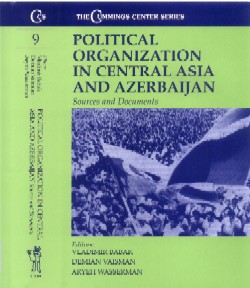 POLITICAL ORGANIZATION IN CENTRAL ASIA AND AZERBAIJAN: SOURCES AND DOCUMENTS POLITICAL ORGANIZATION IN CENTRAL ASIA AND AZERBAIJAN: SOURCES AND DOCUMENTS
Edited by Vladimir Babak, Demian Vaisman and Aryeh Wasserman
This sourcebook, which contains a selection of 90 annotated
documents, demonstrates the spectrum of political and social forces at work in
the six Soviet successor states whose eponymous nationalities are traditionally
Muslim - Azerbaijan, Kazakhstan, the Kyrgyz Republic, Tajikistan, Turkmenistan
and Uzbekistan.The Soviet backwater republics
comprising the subject of this volume had a standard of living that was
generally lower than the national average, and a level of political
consciousness and involvement of the intelligentsia and leading cadres
which lagged behind the rest of the USSR. With the break-up of the Soviet body
politic, these nations were suddenly faced with the challenges of independence,
and entered into a period of transition, in which they struggled to shape the
contours of their new states. By examining the political transition of these six
Muslim republics together, we are able both to follow the threads of their
common legacy and to identify the salient differences among them.
From the fledgling establishment of 'informal groups' in
the early years of glasnost and perestroika, through the zigzags of political
pluralism and repression, the documents in this volume reflect, on the one hand,
these societies' aspirations and goals and, on the other, the obstacles and
constraints which they confronted. The sources further reveal that power was
both engendered and tempered by issues such as ethnic conflict, Islamic
influence, clan, national and linguistic identification, migration, economic
deprivation and demands for entrepreneurship and market economies, ecological
neglect, global orientation, the communist legacy, education and the status of
women.
Two divergent trends of development can be discerned as
the six states evolved into independent entities. The first was a tendency
towards the resurrection of traditional models; the other inclined towards
Western-style institutions and frameworks, usually in their Russian variant. The
question was - and remains - which will prevail.
This book is a vital source for anyone trying to
understand the political complexities of the new Muslim states of the former
Soviet Union, as well as for those seeking models and patterns which might be
relevant to the process of nation-building in the post-September 11 regimes of
Afghanistan and Iraq.
CONTENTS
|
c430 pages
|
2004
| |
0 7146 4838 8
|
cloth
|
£65/$115
| |
|
|
|
|

